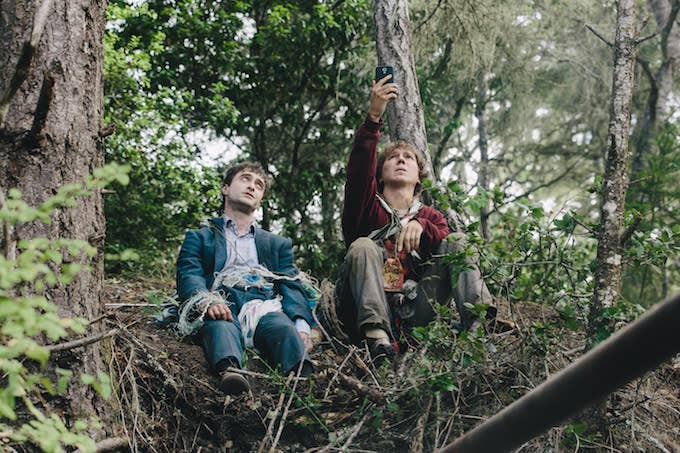
Swiss Army Man is getting its second wind—no pun intended—after garnering an infamous Sundance reputation as the “Daniel Radcliffe farting corpse movie" that was "prompting walk-outs.” Paul Dano, who plays the man dragging said farting corpse around, assures me it was just a consequence of splashy headlines. “That whole thing was pretty exaggerated,” he tells me at the film’s New York premiere at the Metrograph theater, where it seems to have found a much more delighted audience.
What wasn’t exaggerated was the “farting corpse” thing, which literally describes Daniel Radcliffe’s character, “Manny,” a dead man whose flatulence is comically out of control. Directors Daniel Scheinert and Daniel Kwan (professionally known together as “Daniels”) tell me it all started with theidea of a “motor butt” (think: a motor boat, but instead, Daniel Radcliffe's body, propelled by his farts). Several drafts and jokes later, what evolved from this “motor butt” scene became Swiss Army Man, an absurd (mostly platonic) love story of a man finding friendship and newfound hope for life in the least likely companion. As juvenile as the original joke was, what resulted is one of most heartfelt films of the year.

While contemplating suicide, Hank (Dano) spots a dead body washed up on the beach and becomes fascinated with it, especially when it lets out it first deep post-mortem stink bomb. (Love at first fart, if you will.) Though deceased, Radcliffe becomes animated—via the power of imagination, magic, hallucination, full-on delusion—and learns social norms and human behavior from Hank, who names his new friend Manny. Hank teaches him about everything from boners, masturbation, and poop (“everybody poops!”) to what you should or shouldn’t say to pretty girls on buses. The relationship teeters between strong bromance and an almost homoerotic relationship, especially when Hank roleplays as their mutual object of desire (Mary Elizabeth Winstead, who mostly appears as iPhone wallpaper). “I mean, Paul’s character is dressed as a girl at the time and is teaching Manny about love, so in that way it’s a friend doing a friend a platonic favor,” says Daniel Radcliffe. “But on the other hand, they’re two men kissing, so you can read it exactly that gay.”
Whatever the subtext, there’s no denying the foundation of their friendship. While Hank takes Manny under his wing, Manny gives back tenfold, becoming—ehem—a Swiss Army knife of a man. Manny proves to be not just dead weight, but rather the key to Hank’s survival: Hank rides a fart-fueled Manny across waters, while his mouth serves as a water faucet and his boner as a field compass. The Daniels, after all, directed the bonkers, bonerfied “Turn Down for What” video, which may now make the directorial duo “boner auteurs.” Maybe those walk-outs were justified, you might be thinking at this point. But stay with me here.
The Daniels have somehow taken the lowest-brow jokes—your typical “bro comedy” humor—and made a truly artful, delightful, and surprisingly touching film that redefines male friendships. “It's like the least masculine bro comedy ever,” says Kwan. “I think neither of us are very hard, masculine boys. We're very much somewhere in the middle of that spectrum and growing up we never really fit into any definition of boys who like sports or are really good at driving cars really fast. I wore girls' jeans and painted my fingernails and listened to emo music when I was in high school. So this movie just kind of came from that.”

The film feels like, more than anything, a love letter to weirdos, and if you understand its artistic vision, then you walk away feeling like someone out there really gets you. It’s also ecstatically directed, the visuals mirroring the Daniels' colorful music videos, especially in a sequence where Hank and Manny dress up, dine, and dance around a campfire, and reenact Hank’s favorite movie, Jurassic Park. As laugh out loud funny as some scenes are (trust me, the fart jokes are not even the funniest part), the film also deals with darkness. We find Hank suicidal at the beginning of the film, and as much as he finds happiness with Manny, there are also strong undertones of mental illness.
So how do you balance the general optimism of the tone without being bogged by a heavy topic, or making fun of it? “I think the main thing we tried to do was make sure that every little thing that our characters were going through were incredibly relatable despite the fact that it was also insane,” Kwan says. “I just felt like a lot of what Hank had to go through in this film were versions of things that I’ve thought of or versions of things that I have felt exaggerated for the big screen. We’ve always tried to make it feel honest to something that we dealt with on our day to day. Even with all the insanity, that was one of our priorities.”
By the end of Hank and Manny’s insane journey, the fart is no longer just a childish joke. It’s even more than just a literal means for survival. The fart has traditionally been a common symbol for male bonding (“I try to fart in front of my friends,” Dano says, reiterating that point), and in this movie, it’s taken to the extreme. What blossoms from Manny’s gross gassiness is an eternal bond, a bond that not only saved Hank but turns his life around. “We wanted to start with a joke but end with a fart that makes you cry,” Scheinert says. This fart could really make you cry. It could also save your life.
Swiss Army Man is out June 24 (limited) and July 1 (wide).

